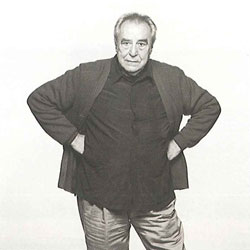João Vieira
João Vieira Vidago ¶ 1934
 |
|
| Créditos fotográficos / Photographic credits: Abílio Leitão |
He entered the Fine Arts School of Lisbon in 1951, but after a period of disappointment with Lisbon's artistic education circles, and a subsequent isolation interlude in his homeland, he returned to the capital and engaged in intense, original artistic activities. Not only did he manage to exhibit, individually, at the Diário de Notícias gallery in 1959, but in the same year he also was the recipient of an annual Gulbenkian Foundation scholarship which took him to Paris to study with painter Arpad Szènes. In Paris he also met René Bertholo and Lourdes Castro, with whom he would set up the KWY magazine project. In 1964 he began lecturing at the Maidstone College of Art, in London, while rubbing shoulders with Britain's art milieu. In 1967 he returned to Lisbon for good. ¶ João Vieira's work has developed over more than five decades, but fundamentally under the sign of an interdisciplinary experimentation, applied to two basic themes: the body and the letter. It is "from" the body - clearly at stake in his first works, his performative acts, which, within the Portuguese context, were evidently groundbreaking - that Vieira reaches the latter, by tapping into the graphic capabilities of the body being turned into a letter, engulfing both of them in multiple plasticities and festivities, or by exploiting exercises that draw the spectator into participating in the discovery of space and time. Expansões (Expansions, 1971) and Incorpório I (Incorporeal I, 1972) are famous examples of the relationship Vieira establishes between his own body and giant letters, immense malleable foam objects that can be adapted to the body. ¶ In the early 90s he created a pictorial series in which numbers replaced the letters and all the alphabetical experiences. Of the last worlds created by João Vieira, we should emphasize the Alfabeto Latino e Grego (Latin and Greek Alphabet, 2000): this consisted of 18 elements made of transparent but coloured plexiglas that were cut and reassembled in such a way that it produced a psychedelic ambient, in which the visual experience of the colourful, alphabetical-alluding letters seemed to underline the unique pleasure that has always radiated from Vieira's oeuvre.
View the embedded image gallery online at:
http://cvc.instituto-camoes.pt/biografias-en/joao-vieira-52331.html#sigFreeIdfbfef677fb
http://cvc.instituto-camoes.pt/biografias-en/joao-vieira-52331.html#sigFreeIdfbfef677fb


